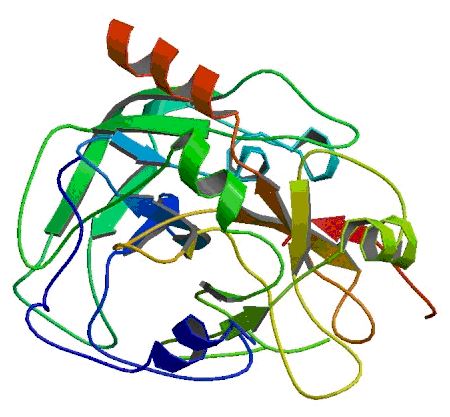Introduction of PAR4
PAR4, also referred to coagulation factor II receptor-like 3 (F2RL3) or thrombin receptor-like 3, is a type I receptor protein of 41 kDa that encoded by the chromosome 19p13.11. It has 385 amino acids and belongs to the protease-activated receptor (PAR) subfamily. Other members of PAR family include PAR1, 2 and 3, and among them, PAR1 and PAR3 can be activated by thrombin, PAR2 and PAR4 by several serine proteases. PAR4 is also a component of the G-protein-coupled receptor (GPCR) family.
| Basic Information of PAR4 | |
| Protein Name | Proteinase-activated receptor 4 |
| Gene Name | PAR4 |
| Aliases | F2RL3, F2R Like Thrombin Or Trypsin Receptor 3, Coagulation Factor II (Thrombin) Receptor-Like 3, F2R Like Thrombin/Trypsin Receptor 3, Thrombin Receptor-Like 3 |
| Organism | Homo sapiens (Human) |
| UniProt ID | Q96RI0 |
| Transmembrane Times | 7 |
| Length (aa) | 385 |
| Sequence |
MWGRLLLWPLVLGFSLSGGTQTPSVYDESGSTGGGDDSTPSILPAPRGYPGQVCANDSDT LELPDSSRALLLGWVPTRLVPALYGLVLVVGLPANGLALWVLATQAPRLPSTMLLMNLAA ADLLLALALPPRIAYHLRGQRWPFGEAACRLATAALYGHMYGSVLLLAAVSLDRYLALVH PLRARALRGRRLALGLCMAAWLMAAALALPLTLQRQTFRLARSDRVLCHDALPLDAQASH WQPAFTCLALLGCFLPLLAMLLCYGATLHTLAASGRRYGHALRLTAVVLASAVAFFVPSN LLLLLHYSDPSPSAWGNLYGAYVPSLALSTLNSCVDPFIYYYVSAEFRDKVRAGLFQRSP GDTVASKASAEGGSRGMGTHSSLLQ |
Function of PAR4 Membrane Protein
This protein is identified as a low-affinity thrombin receptor and plays pathophysiological a role in inflammation, blood coagulation, and response to pain. In humans, PAR4 has been discovered highly expressed in lots of tissues, such as the lung, testis, pancreas, thyroid, and small intestine. There is reported that hypomethylation at this gene may be correlated with lung cancer in patients.
 Fig.1 Protein structure of PAR4.
Fig.1 Protein structure of PAR4.
Application of PAR4 Membrane Protein in Literature
The data of this report demonstrated that PAR4-AP-induced platelet reactivity among PAR4 rs773902 is correlated with the changed intensity of Ca2+ mobilization and ERK (Extracellular-signal-regulated kinase) activation.
This review summarized the PAR4 characteristics, including structure, activation mechanism, and role in the pathophysiology of diseases, as well as the connection of PAR4 targeting for improved cardiac protection. In all, this paper highlights the importance of PAR4 antagonists and its promising application in different cardiovascular diseases (CVDs).
The study provided the first testification of spontaneous bleeding in Par4-/- mice, suggested that a dam's first litter offers more hemostatic challenge than followed litters, and revealed a vital role for platelets-and more particularly thrombin-induced platelet activation in hemostasis during these traumatic births.
This article uncovered that the endogenous H2S produced by cystathionine β-synthase (CBS) or cystathionine γ-lyase (CSE) caused about hyperalgesia mediated via MIF in mice with PAR4-induced bladder pain, without resulting in bladder injury and altering micturition behavior.
The authors of this paper presented a study demonstrating that miR-17-3P is significant in colorectal cancer (CRC) cell survival through targeting Par4, which indicates a novel finding regarding CRC progressions in humans.
PAR4 Preparation Options
To produce the soluble and functional membrane protein targets, the versatile Magic™ membrane protein production platform in Creative Biolabs offers quantities of flexible options for your particular projects. Aided by our versatile Magic™ anti-membrane protein antibody discovery platform, we also provide customized anti-PAR4 antibody development services.
As a leading provider and a forward-looking research institute in the field of the membrane protein, Creative Biolabs has won a great reputation around the world for successfully completing various challenging projects. Over years, we have successfully accomplished lots of functional membrane proteins for our customers and are skilled at designing one-stop, custom-oriented service packages regarding different membrane protein targets. Please feel free to contact us for more information.
All listed services and products are For Research Use Only. Do Not use in any diagnostic or therapeutic applications.